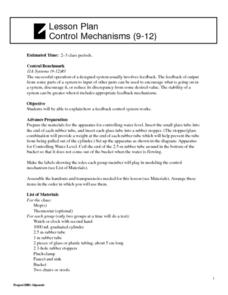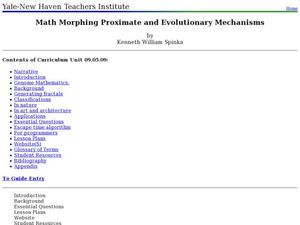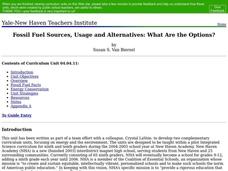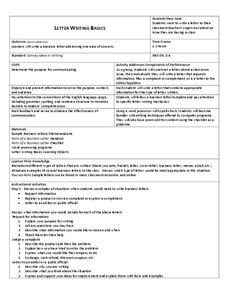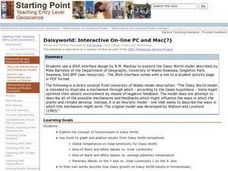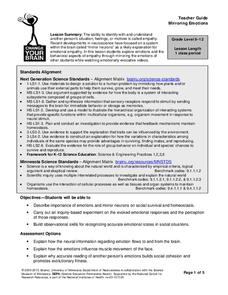Serendip
Homeostasis, Negative Feedback, and Positive Feedback
So many bodily activities depend on homeostasis! Give learners a solid background to understand the basic process of the human body. Scholars first examine negative feedback loops contributing to body temperature regulation and then a...
Curated OER
Control Mechanisms
Students explain how a feedback control system works. They model a feedback control mechanism for controlling water level by observing the flow rate of water in a cylinder. In addition, they graph their data. Script for lesson is included.
University of Minnesota
Homeostasis of Thermoregulation
Whether you're battling the flu or trying to warm up on a chilly day, your body's ability to react to temperature change is fascinating! Anatomy scholars discover the fantastic feedback loops that control body temperature in a rigorous...
Curated OER
Gene Regulation Mechanisms
Students explore the control of expression of DNA into proteins which is divided into two main categories: transcriptional and post-transcriptional. They construct examples of the control mechanisms and discuss disease processes that...
Virginia Department of Education
Biotechnological Issues and Bioethics
Culminate a bioethics unit with the implementation of a lesson that incorporates the Socratic method to encourage class feedback and participation. Pupils participate in a discussion on bioethics and morality, complete a...
Illustrative Mathematics
Why Does SSS Work?
While it may seem incredibly obvious to the geometry student that congruent sides make congruent triangles, the proving of this by definition actually takes a bit of work. This exercise steps the class through this kind of proof by...
Curated OER
Gene Regulation Mechanisms
Students explore genetics. They discuss how chromosomes and/or genes are regulated during the life of an organism. In a lab setting, students compare and contrast the genomic regulation of prokaryotic and eukaryotic cells using...
Curated OER
Math Morphing Proximate and Evolutionary Mechanisms
Students identify the different types of fractals. In this geometry lesson, students use math to analyze different biological phenomena. They collect data from the experiments and construct graphs.
Curated OER
Coaching, Conferencing, and Correcting
Young scholars, after revising their writing and identifying their strengths and weaknesses, edit their writing incorporating teacher feedback and examples from class exercises. In addition, they continue working on individual writing...
Curated OER
Fossil Fuel Sources, Usage and Alternatives: What Are the Options?
Students examine the relationship between energy and the environment. In groups, they participate in experiments to discover the law of thermodynamics and the differences between potential, kinetic and mechanical forms of energy. They...
Curated OER
Language Arts: Writing Skills Development
Students improve writing skills by expanding their self-perceptions. Next, they develop idea lists for writing topics. Their ideas become the basis for a class newspaper. following the creation of a group composition, students write...
Curated OER
Letter Writing Basics
Students write a business letter with information regarding specific writing mechanics. In this writing lesson plan, students learn to write a business letter and they focus on one area of concern. Students follow a business letter...
Curated OER
Mankind's Fascination With Flight
Young scholars read various novels and articles about the contributions of the Wright Brothers. Individually, they are tested on their comprehension of the material and discuss. In groups, they research the role of the people in their...
Curated OER
Physics of Sound: How We Hear Sounds
Middle schoolers examine the way they hear sounds. In groups, they label and identify the functions of the different parts of the ear. After reading a book by Helen Keller, they research the mechanisms of sound and how sounds are...
Curated OER
Accountability
Students review issues of current and national interest of Australia. They experience Question Time through a role-play activity. Students reflect on the effectiveness of Question Times as a method of public accountability. They...
Curated OER
Simple Machines, Engines and the Environment
Young scholars examine and describe the six main simple machines. In groups, they work with an inclined plane to calculate the ideal and actual mechanical advantages of the plane. Using their results, they must determine the efficiency...
Curated OER
Wimshurst Machine
Students examine what a Wimshurst machine is and how it operates. In this mechanics lesson students build a Wimshurst machine and watch it in action.
Curated OER
Daisyworld: Interactive On-line PC and Mac
Students use a JAVA interface to explore the Daisy World model to illustrate a mechanism through which - according to the Gaian hypothesis - biota might optimize their abiotic environment by means of negative feedback.
Curated OER
Mankind's Fascination With Flight
Students discuss, examine and appreciate the science and inspiration of flight. They study the terms and mechanics of powered flight and demonstrate that the heating of air makes it lighter and therefore rise. They discuss and...
University of Minnesota
Mirroring Emotions
Do you ever give your class the "teacher look"? Without saying a word, they become silent and engaged (hopefully). How do they know what you're thinking? Explore the concept of nonverbal communication and how it relates to our...
University of Minnesota
Virtual Neurons
It's electric! Young anatomists use Virtual Neurons software to build, control, and analyze complex nerve circuits within the body. Colorful and packed with content, class members enjoy interacting with the nervous system...
University of Minnesota
What's the Deal? Addiction Card Game
Addiction is a big deal! Playing a game of cards helps learners understand the concept of addiction. Through their analysis, they examine the potential for addiction and how it varies for each individual.
University of Minnesota
Dendritic Spines Lab
This is your brain on drugs ... literally! Your neuroscientists-in-training examine the evidence of drug use on the human brain and how neurons change their connectivity when altered by drugs. They then work together to create testing...
University of Minnesota
Sheep Brain Dissection
Bored with frog and earthworm dissections? Had your fill of fetal pigs? Anatomy students will be intrigued by the sheep's brain, and you will be prepared with guiding questions, extension activities, and pictures as they dissect one —...

